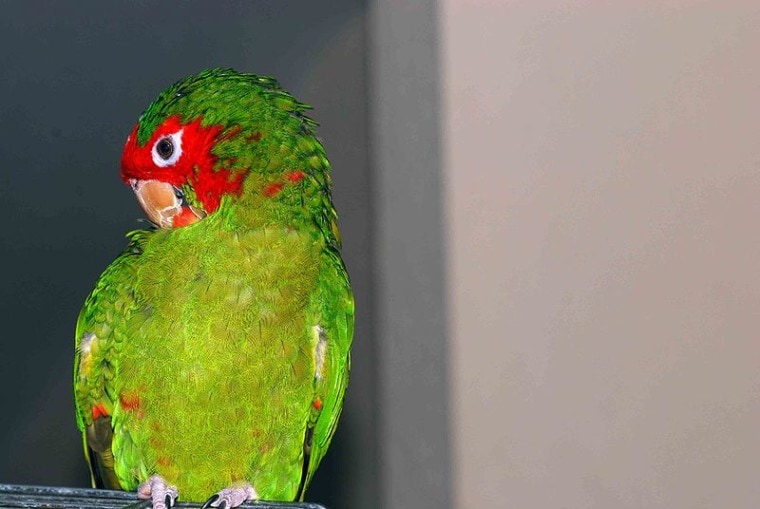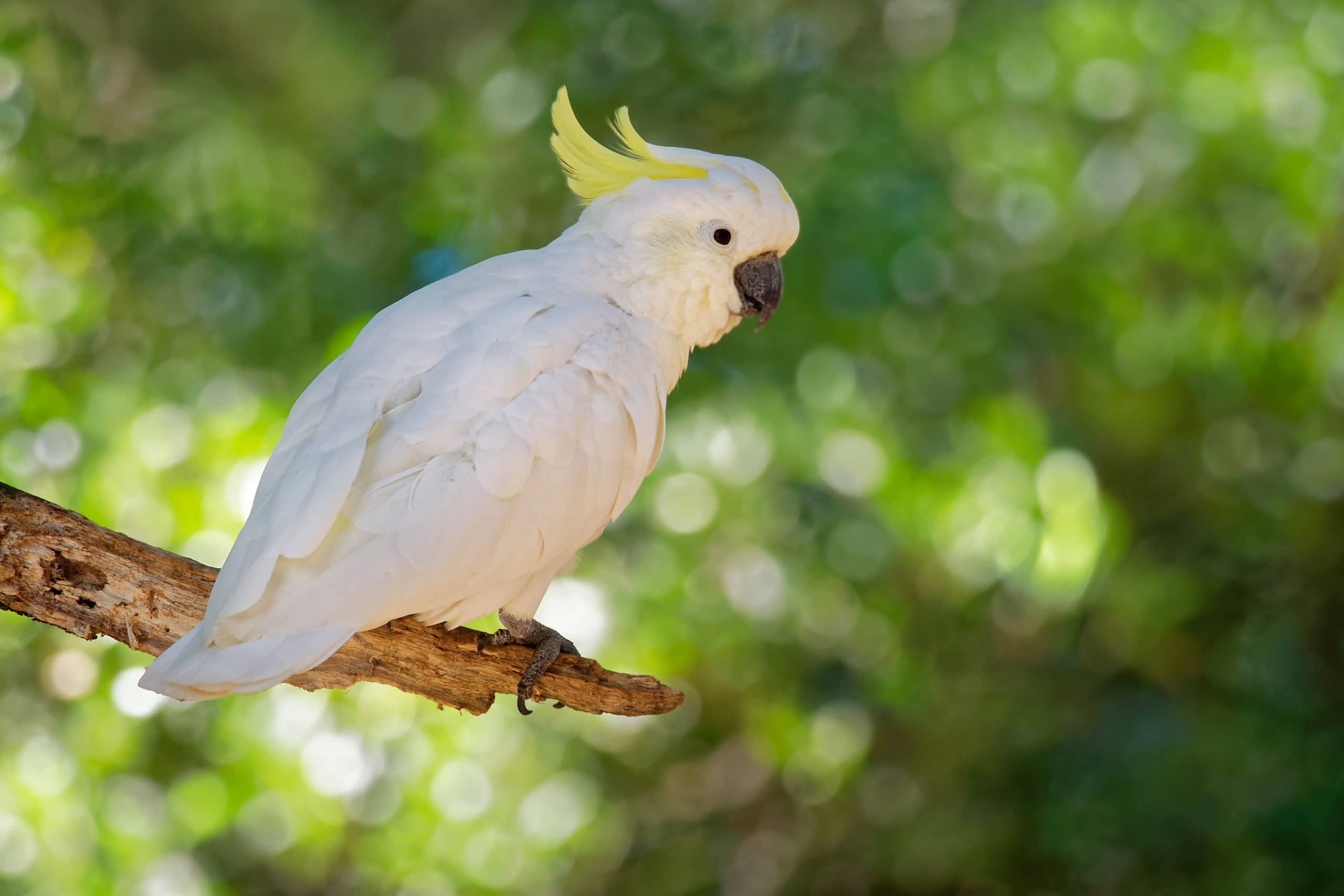
While the Mitred Conure is a beautiful bird, they can be a bit of a handful if you don’t know what you’re getting yourself into. But when you properly care for them, they can make the perfect pet for your home and give you tons of love and affection in return.
But what can you teach a Mitred Conure to do, and how much work goes into caring for this bird? We answer those questions and more here.
Species Overview

| Common Names: | Mitred Conure, Mitred Parakeet |
| Scientific Name: | Psittacara mitrata |
| Adult Size: | 13 to 15 inches and 7 ounces |
| Life Expectancy: | 20 to 30 years |
Origin and History
Originally from the Andes Mountains in Peru, Bolivia, and Argentina, Mitred Conures were captured en masse in the 1980s and transported to the United States. While the people kept the majority of the birds as pets, many were released or escaped.
Today, you can find invasive populations of the Mitred Conure in Florida, California, and Hawaii, as these regions have conditions where the Mitred Conure can thrive.
However, farmers consider Mitred Conures in these regions a nuisance bird because among their primary food sources are farm-grown crops. Their higher intelligence also makes them harder to trick, which leads to even more crop damage.
Today, most captive Mitred Conures can’t survive in the wild, even in these regions, because they have spent their entire lives in captivity.
Temperament
The Mitred Conure is an extremely playful, smart, and energetic bird, but they’re also extremely labor-intensive and require a ton of care.
If they don’t get the attention that they need, their sweet and loving nature can often turn aggressive or even self-destructive. Mitred Conures can get a bit nippy even when well cared for, and they can be moody at times.
Finally, expect your Mitred Conure to be a chatterbox, even if you do everything right when caring for them. This is especially prevalent at dawn and dusk and whenever they want attention.
They are attention-seeking birds and need several hours of attention each day. They will get goofy and ridiculous to try to get your attention. However, if that doesn’t work, they can get depressed, so you can’t ignore your Mitred Conure for extended periods.
Speech & Vocalizations
The Mitred Conure is a vocal bird, even if they’re getting all the attention that they need. They love to talk and often just want to hear their own voice.
They also spend a ton of time listening to their surroundings and trying to mimic the sounds that they hear. This makes it easy to teach them different words, and they’ll often pick up words even if you aren’t trying to teach them!
Mitred Conure Colors and Markings

Unlike many captive birds, Mitred Conures all have a similar appearance. Almost all the feathers on their body are green, but they have red splashes throughout, especially around their face and legs.
They have a completely white beak, gray feet, and white rings around their eyes. They also have long tail feathers that give them a sleek and regal look.
Both females and males look identical, so without a professional’s help, you likely won’t know your bird’s sex.
They look similar to other Conure breeds, despite being a completely different breed.
Caring for the Mitred Conure

Caring for your Mitred Conure is a ton of work, but you do have a few different options. First, you need to decide how many birds you want. You can keep just one Mitred Conure and have them bond with you. While this will allow you to focus on hanging out with your bird, it also requires a bit more work and time.
Another option is to house these birds in pairs. While you should avoid housing a male and female together because they’ll mate, any other pairing is fine.
But even if you have two birds that have bonded, that doesn’t mean you can skip hanging out with them entirely. They’ll still need plenty of exercise and attention.
Do not house different bird species together, as this can lead to aggressive behaviors and other concerns.
Whether you have one bird or two, fill their enclosure with plenty of activities to stimulate them both physically and intellectually, and cycle them in and out so your bird can’t master them.
From there, ensure that they have multiple perches and places to climb, as this will both entertain them and count as exercise. It also helps if you have activities outside of their cage for when you’re giving them attention and playing with them.
Common Health Problems
While the Mitred Conure is a relatively healthy bird, there are a few health problems that you need to keep an eye out for. If you suspect that your bird has any of these conditions, you need to take them to a vet as soon as possible.
Keep in mind that birds hide health problems for as long as possible as a self-defense mechanism in the wild, so if you’re noticing symptoms, they’re probably already quite sick.
The best thing that you can do to keep your Mitred Conure as healthy as possible is to keep up with their care requirements, like socialization and cage cleanings.
A dirty or dusty environment will lead to respiratory infections, and not enough socialization will lead to depression and self-mutilating behaviors.

Diet and Nutrition
The best and easiest way to give your Mitred Conure a balanced diet is to give them specialized food pellets that you can find at a pet store. Supplement these pellets with fresh fruits and vegetables for a little added variety.
By adding the food pellets, you’re ensuring that your bird isn’t missing any necessary nutrients. Feed your Mitred Conure the occasional nuts as a treat, but don’t overdo it on the fresh fruits, veggies, or nuts. Always make sure your Mitred Conure has eaten their pellets.
If you’re converting your bird from a seed-based diet to a pellet diet, you’ll need to do it slowly because they don’t always see the pellets as food initially. This takes time and patience, but it is a healthier alternative for your bird.
Exercise
Giving your Mitred Conure enough exercise is one of the most important things that you can do for their health. These birds need at least 4 hours of exercise and socialization per day, which means plenty of time outside their cage.
Be sure to play with them and give them plenty of affection during this time. Otherwise, they’ll resort to self-mutilating behaviors. This isn’t a requirement that you can skimp on, so don’t adopt a Mitered Conure if you don’t have the time.

Where to Adopt or Buy a Mitred Conure
While you typically can’t find a Mitred Conure at a store like PetSmart or Petco, they’re not the most challenging birds to track down. All you need to do is find an exotic bird breeder near you and reach out.
Expect to spend anywhere from $500 to $2,000 on your bird. The price variance depends on various factors, including the local market and the bird’s lineage.
Another big difference that affects the price is whether the bird is hand-fed or not. Hand-fed birds tend to be tamer but they also cost a bit more.
Conclusion
While the Mitred Conure is a regal and adorable bird, they require a ton of work and attention to keep happy and healthy.
Keep in mind that these birds can live for up to 30 years and will need attention constantly, so deciding to purchase one is no small decision. But it’s those same concerns that make them such great pets.
They’ll spend tons of time bonding with you, and they’ll live an extremely long time. They’re a great companion, just make sure you have the time and energy to care for them!
Featured Image Credit: bluepaints, Pixabay








